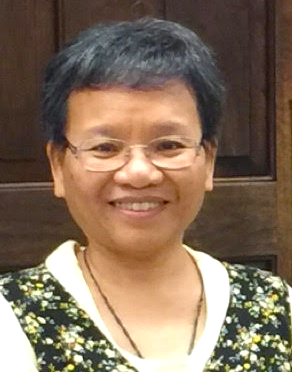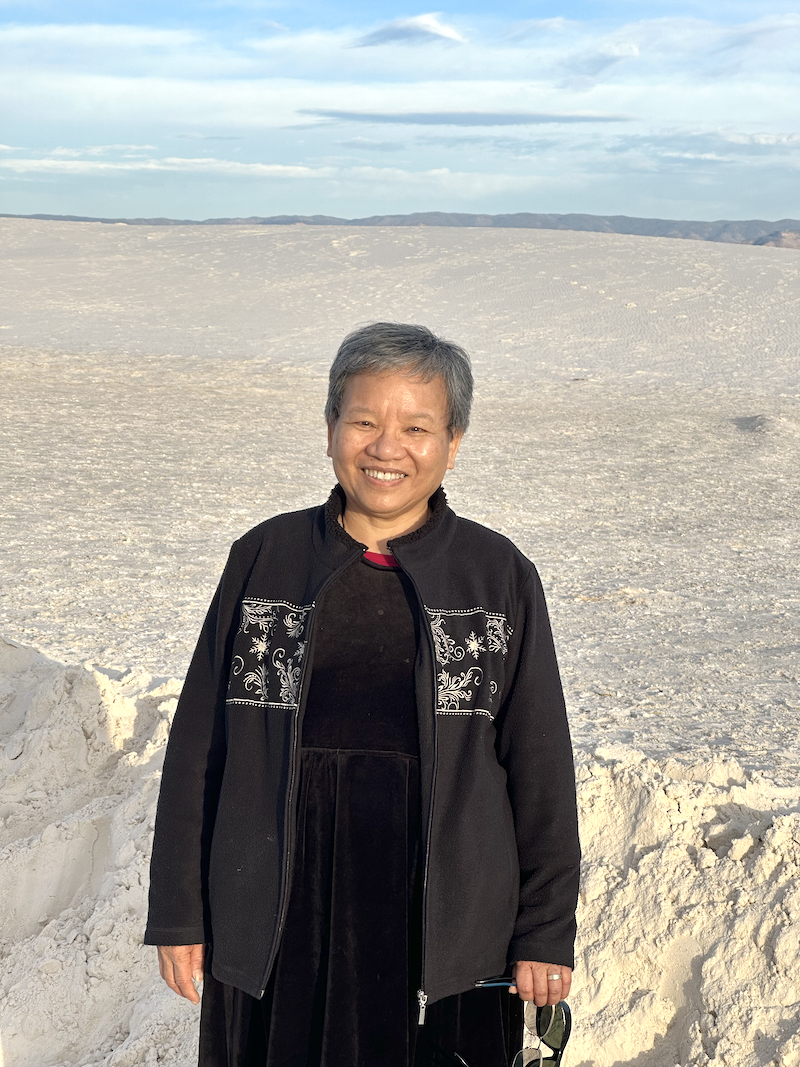 Interview with Adelina Hills, LMFT by Liliana Ramos, LMFT, Director-at-Large
Interview with Adelina Hills, LMFT by Liliana Ramos, LMFT, Director-at-Large
Back to Spring 2023 Newsletter
Liliana: Hi! Thank you for doing this, Adelina. Can you introduce yourself, who you are, what you do. How long have you been a therapist?
Adelina: I have been licensed for over 15 years. I started my professional career late. I am an MFT. I have a certification in Somatic Experiencing (SE). After that I studied and got certified in NeuroAffective Relational Model (NARM). Those are the two certifications I have.
Liliana: What made you get certified in both of those?
Adelina: It’s because of my own childhood trauma: I lost a leg. So, I’ve always been interested in psychology from the body perspective. I graduated from Institute of Transpersonal Psychology (ITP) , the focus is on body, mind, and spirit. Through several courses helped me to realize that I had disconnected myself from my body. This is why I started to look for a somatic approach. I found it helpful as a client, so I decided to become a practitioner.
Liliana: So you were already a therapist when you received therapy through somatic experiencing. Okay, so how do you help clients with this approach?
Adelina: The biggest benefit is to pay attention to the body. Our mind might forget what happened but our body remembers. For example, when clients talk about their trauma, they might hold their breath without being aware. I then bring up my observation or ask them to notice their body sensations.
Liliana: Do you work with SE with all of your clients?
Adelina: I do talk therapy with SE lenses. I tell every new client that I will ask them what they feel in their body so that they’re not surprised when I ask them.
Liliana: Do you work with clients in person or telehealth?
Adelina: Since COVID I only work through telehealth.
Liliana: How does SE differ in-person versus telehealth?
Adelina: In-person sessions, it’s not a problem because I can see the whole body. In telehealth, sometimes I can observe and sometimes I cannot, so I tell clients that I will rely on them to report to me how they feel. Nonetheless, the questions are not different between in-person and telehealth.
Liliana: I know you work with couples. Do you use this approach with couples?
Adelina: I do not use this approach with couples. I mainly use Terry Real “Relational Life Therapy” model for couple therapy.
Liliana: What else can you tell us that would be good for therapists to know about using SE in therapy?
Adelina: I think that lots of therapists do not pay attention to the body. SE is a good tool to track body sensations which enhance self awareness from the somatic level.
Liliana: Can you do touch therapy as a therapist?
Adelina: Yes, in the last phase of Somatic Experiencing training, they teach touch. Practitioners have to get consent from clients to perform touch work. However, I don’t do touch anymore. Personally, it’s very powerful. But if I do touch, I really need a massage table. So when people come for SE, I tell them that I don’t do touch.
Liliana: I know you decided to learn Somatic Experiencing because of your personal experience with that type of therapy and because of your trauma. What made you become a therapist?
Adelina: Definitely my trauma because of my accident at a young age. I’ve always been interested in psychology. I never got to study psychology in Taiwan. When I came to the US, I first improved my English, then I decided to pursue my psychology degree .
If I may share a story: I was introduced to a psychologist by my English teacher. He is a Native American psychologist. My first psychotherapist, Martin Brokenleg, PhD, a professor at Augustana University, South Dakota, helped me open my eyes to a totally different culture. At that time, I couldn’t drive because of my trauma; fortunately his office was within walking distance, so I could see him by walking to his office. I only saw him for three sessions because I wasn’t ready to process my trauma at that time. However, what made an impression on me is that I asked him why I cannot drive. He told me why. I will never forget his statement: “when you are able to drive, you are going to be a very safe driver”. I remember right after I left his office, I told myself, “I want his job.”
Liliana: Why did you want his job at that time?
Adelina: He saw me. Plus, I was always interested in psychology when I was in Taiwan.
Liliana: Why were you interested in psychology when you were in Taiwan?
Adelina: I think it was connected with trauma: I lost my childhood overnight. I think when people go through trauma they have to process so much. I could not play with my classmates and peers. I could only watch them. I think people become therapists, because of something that they went through?
Liliana: How does your culture being Taiwanese and being able to speak Mandarin help you with your practice?
Adelina: I have quite a few Chinese clients. They come to me because of my familiarity with the culture. Sessions could be conducted in English or Chinese or mixed. It is handy when I could just use a couple of Chinese phrases that can catch what clients want to express but it is hard to find words in English.
Liliana: So most of your clients are Chinese or Asian?
Adelina: It’s a mix. I have Americans, Asian and Chinese clients.
Liliana: If a therapist was working with an Asian client, what are some of the themes that they would bring up or that a therapist who is not Asian needs to be aware of so that they can provide a more meaningful experience for the client?
Adelina: One thing is that the Westerner is more individualistic. Western culture talks about boundaries. This is a very hard concept for the Chinese community to grasp. Also, when working with Chinese clients, it is important to know that they will want advice from the therapist. They want the therapist to tell them what to do, and make decisions for them. They will follow the
prescriptions and then expect the result. They also want to have quick results or have high expectations. It is important to educate our Chinese clients what therapy is about.
Liliana: So because that is such an important part of the culture, when a person is suffering from intergenerational trauma or developmental trauma, how do you work with that and still stay true to the culture?
Adelina: I think self compassion is important for clients to learn and practice. To let my clients know that self care is not the same as being selfish.
Liliana: What would you like therapists to take away from this article?
Adelina: It’s harder to work with clients from a different culture. I would say to be curious whether you share the same or different culture. If you and the client have the same cultural background, the family culture can still be different. I think that maintaining curiosity is important. Just be humble and say ,“I need you to educate me.”
Liliana: When you talk about somatics, the lived experience is in your body, heart, and mind. They can still work with clients from different culture as long as they maintain the curiosity and humility.
Adelina: Right. It’s impossible for us to have all the experiences that a client brings into therapy. For example, the client who has been severely abused: I don’t have that type of experience. So as therapists we need to maintain curiosity. I think that in therapy it’s really about connection. It’s about the clients feeling that we care.
When we say culture, I don’t want to limit it to the color of the people or where you come from, I want to include the LGBTQ and religious culture.
Liliana: Yes, so true. It could be the LGBTQ, military, or first responder culture. Maybe even the medical field, inter-sectionalities of the different parts of the person.
Adelina: Yes, I totally agree.
Resources
Somatic Institute (2023). What is Somatic Experiencing? Retrieved from http://somaticinstitute.com
NARM Training Institute (2021). What is NARM? Retrieved from https://narmtraining.com

Adelina Hills is a bilingual (Mandarin Chinese and English) Marriage and Family Therapist licensed in the state of CA. She has been licensed for over 15 years and has a private practice in San Jose. She works with adult individuals and couples using approaches of Somatic Experiencing (SE), Neuro-Affective Relational Model (NARM) and Relational Life Therapy. She is dedicated to helping individuals and couples who are struggling with trauma, depression and anxiety.
Back to Spring 2023 Newsletter
